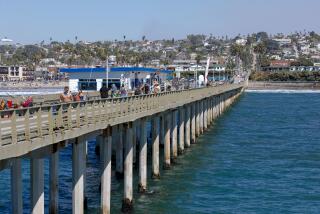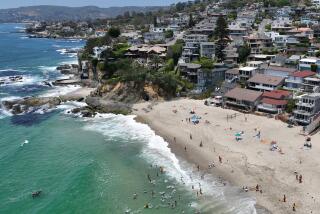Limit on New Sea Walls Urged
With erosion gnawing at 85% of Californiaâs coastline, state officials are proposing steps to reduce building of sea walls and other shoreline armoring that tend to accelerate the loss of sand.
The California Resources Agency, in its first proposed revision of statewide coastal erosion policies in 23 years, suggests that arming the coast to protect seaside houses be considered only as the last option.
The draft proposal, which ultimately could lead to changes in the 1976 California Coastal Act, comes after years of rapid increases in armoring of the coast and declarations by environmental groups that walls and jetties destroy beaches.
In the latest such declaration, the Surfrider Foundation issued its second annual State of the Beach report Tuesday listing Bolsa Chica State Beach in Orange County among the five most threatened surfing beaches in the continental United States, Hawaii and Puerto Rico.
Surfrider worries that a proposal to build a pair of jetties across the beach to allow seawater into the Bolsa Chica wetlands would unleash pollutants into the surf zone and increase beach erosion.
âMany of our favorite surfing areas may be threatened or degraded by coastal development such as the construction of harbors, groins or jetties,â says the report of the 26,000-member organization.
Surfrider said California now has 130 miles of shoreline armoring, almost four times more than in 1971.
The construction of rock breakwaters, concrete sea walls and revetments continues unabated, it said, causing currents to narrow some popular beaches and scour others until no sand remains.
By identifying such conflicts and lobbying state and local officials, âsurfers can prevent the further loss of great surf spots such as âKiller Danaâ in California, which was lost as a result of construction of the jetty that created Dana [Point] Harbor,â the report concludes.
Protecting beaches is important to the stateâs economy because direct spending at the beach through tourism and recreation contributes about $14 billion a year, said Brian Baird, ocean program manager for the Resources Agency.
Working with a consortium of other state agencies, the Resources Agency hopes to establish a model policy that would promote alternatives to adding more hardened structures along the stateâs 1,100-mile coastline, he said.
âHopefully, we will eliminate the need for protective structures,â Baird said. âIs this a panacea that will solve erosion problems? No. Will it help? Yes.â
The agencyâs proposal suggests consideration of long-range solutions such as restoring the supply of sand that used to wash down Californiaâs rivers and streams.
Much of that natural sand replenishment has stopped over the years as rivers have been dammed and growing cities have paved more land, reducing the flow of sediment.
In addition, the agency recommends that new construction avoid hazardous areas prone to erosion, that officials consider the feasibility of relocating threatened buildings before fortifying the coast, and that they dump sand on or near eroding beaches as the first line of defense.
Of all the state agencies, the California Coastal Commission has struggled the most with protecting houses and other structures built too close to the ocean.
Chairwoman Sara Wan said the issue regularly creates a public policy dilemma: The commission is required by law to approve sea walls that protect private property, but the walls then rob sand from public beaches.
âYou end up protecting the house, but losing the beach,â she said.
The Coastal Act, in the way itâs written, has contributed to the problem, she said.
Houses are supposed to be built far enough back from the water that they will not require a protective sea wall to keep from toppling into the sea. Yet once a house is approved and built, the law considers it an âexisting structureâ and mandates that a protective sea wall âshall be permittedâ if needed.
As a result, said Mark Massara of the Sierra Club, âwe have this army of geologists who testify that the setbacks for proposed houses will never be affected by erosion. Then two years later, the geologists--sometimes the same ones--come back and say, âWe underestimated the effect of the waves and the weather and we need a wall.â â
Massara suggested that any new statewide policy needs to toughen the laws.
At a minimum, he said, the section of the law on granting permits for sea walls should be changed to give the Coastal Commission flexibility. A better fix, he said, would be to follow the lead of Oregon and seven other states that forbid sea walls from ever being erected to protect houses built after a certain date.
âCalifornia,â he said, âis way behind what other states are doing.â
State officials plan to hold public workshops around the state on their draft coastal erosion plan. Hearings will be held at 9:30 a.m. Thursday at the Newport Beach Public Library and 7 p.m. Tuesday at the Ken Edwards Center in Santa Monica.
More to Read
Sign up for Essential California
The most important California stories and recommendations in your inbox every morning.
You may occasionally receive promotional content from the Los Angeles Times.










